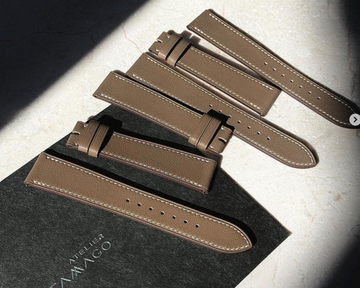Step-by-Step Guide: How to Safely Replace Your Watch Strap with a Spring Bar Tool
For watch collectors, dealers, and enthusiasts, a well-crafted leather strap can elevate the elegance of a timepiece like a Patek Philippe, Rolex, or Audemars Piguet. At Atelier Tamago, we specialize in artisanal leather watch bands designed to complement luxury watches. Whether you’re refreshing a vintage piece or customizing a modern classic, this guide will help you confidently replace your watch strap using a spring bar tool—while protecting your investment.
Tools You’ll Need
- Spring bar tool (dual-ended with a fork and pin)
- Replacement leather strap (ensure correct width: measure between lugs)
- Soft cloth or mat (to protect the watch case)
- Tweezers (optional, for handling small parts)
Step-by-Step Instructions
1. Measure Your Strap Width
- Use a caliper or ruler to confirm the lug width of your watch. Reference the manufacturer’s specs if unsure
2. Secure the Watch
- Place the watch face-down on a soft cloth to avoid scratches.
3. Locate the Spring Bars
- Identify the small notches on the underside of the lugs where the spring bars connect the strap to the case.
4. Remove the Old Strap
- Forked End Method:
- Slide the forked end of the tool between the strap and lug.
- Gently compress the spring bar by pressing inward, then carefully pull the strap away from the case.
- Pin End Method (if spring bar ends are visible):
- Use the pointed tip to press the spring bar inward until it releases.
Caution: Apply even pressure to avoid bending spring bars or damaging the lugs.
5. Prepare the New Leather Strap
- Align the replacement strap’s holes with the watch lugs.
- For Buckle Replacement:
- Detach the original buckle by compressing its spring bar
- Attach your preferred buckle to the new strap using the same method.
6. Install the New Strap
- Insert one end of the spring bar into the lug hole.
- Use the forked tool to compress the opposite end of the spring bar, sliding it into place until it clicks securely.
- Repeat for the second lug.
7. Final Adjustments
- Ensure the strap sits flush against the case.
- Test the spring bars by gently tugging the strap to confirm stability.
When to Seek Professional Help
While DIY replacement is rewarding, delicate vintage watches or complex bracelets (e.g., integrated designs) may require expert handling.
We blend traditional craftsmanship with modern sophistication. Explore our curated collection of leather straps or design a bespoke strap tailored to your watch.
Subscribe to our newsletter for exclusive guides, new releases, and 10% off your first order.
By empowering collectors with knowledge, we ensure your prized watches always make a statement—one stitch at a time.








